Never one to shy away from a new challenge, cyclist and freelance journalist Juliet Elliott loves travelling the globe in pursuit of adventure and belly laughs. An ex-professional snowboarder who hung up her boots to go on tour with a metal band, these days you’re more likely to find her cycling than sliding sideways down a mountain. This article was first published on 16th September 2016 and is a feature piece from Totally Active.
Widely credited as the invention of farmer Sondre Norheim, Telemark skiing is considered the forerunner of modern skiing, as we know it today. Invented in the 1800s in the Telemark region of Norway, the technique of lifting your heel was developed to allow the long, wooden skis common at the time to turn more easily, which ultimately allowed skiers to tackle steep descents rather than just stick to cross-country trails. As well as descending, the ‘freeheel’ allows you to climb up the mountain, bringing previously inaccessible areas within reach.
With it’s uplifted heel, the Telemark turn looks similar to a curtsey, giving the sport a graceful air and the technique’s smooth, deep turns allow a feeling of unrestricted freedom and a natural connection with the snow.
For most, it’s not immediately easy to pick up, and there in lies its exclusive appeal – it’s a purist’s sport for the committed with a tight-knit community of devotees.

The instructor
“You can like skiing, but you can only love Telemarking.”
A talented skier, Enrico Cirillo fell in love with telemarking ten years ago in Italy, and now shares his love of freeheel skiing by instructing clients of Oxygene and VIP Ski in Val d’Isère. His enthusiasm is infectious and never-ending, but what is it about Telemarking that he enjoys so much?
“It’s a lot more natural and intuitive than regular skiing,” Enrico tells me. “It’s less complicated, an expression of freedom – more go with the flow. Once you’ve tried Telemarking in powder snow, you’ll understand. It’s a different sensation entirely.”
Grabbing my gear from the hire shop, I ask him why I, as a snowboarder, should give it a go, and I’m promptly told that skiing is superior to snowboarding in every way, and that Telemarking is the best, purest kind of skiing. It’s pointless to argue so I take his word for it.
Enrico tells me the ideal conditions are soft, fresh snow as Telemarking transmits more vibrations than Alpine, making hard, icy pistes even less enjoyable. Alongside the best of the white stuff, you’ll need quads of steel – the deep lunge required for a Telemark turn requires strength and flexibility.
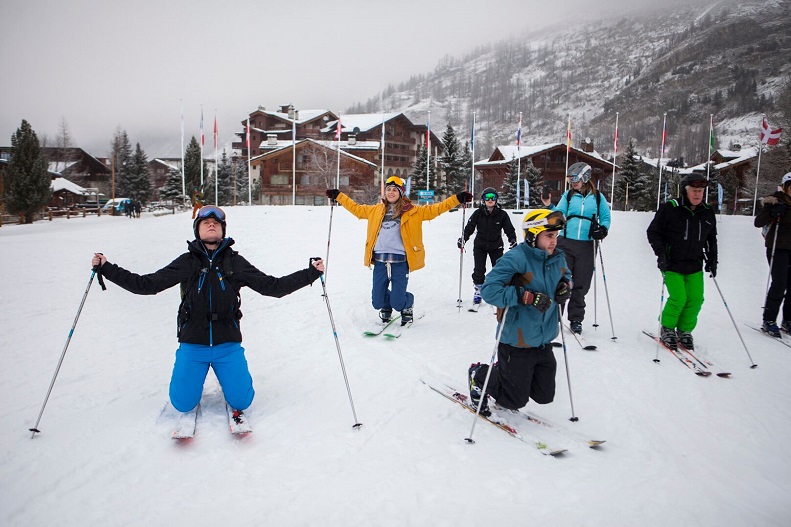
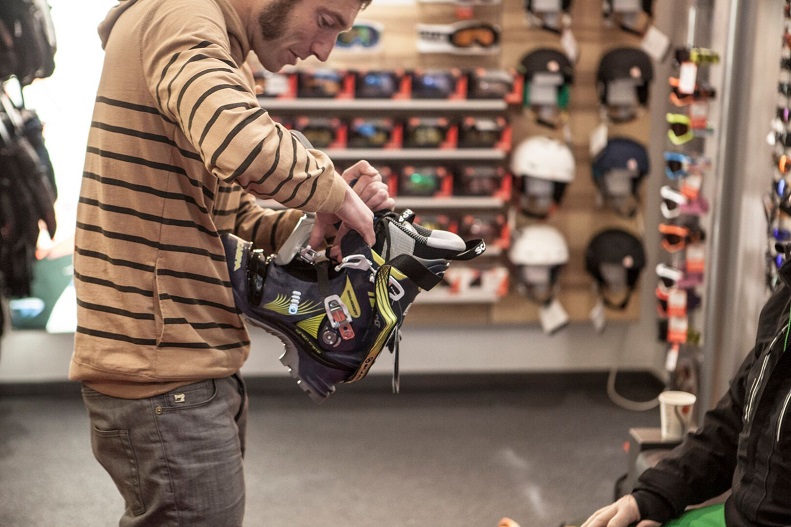
Enrico’s top Telemarking tips:
- Slide your front leg forward into a lunge when you lift your heel.
- Bend both legs as you lunge but keep your torso completely upright.
- Turn your entire body rather than simply rotating your shoulders.
- Point your outside hand back up the slope as you turn.

First time telemarking
I’m facing back up the piste, legs facing opposite directions, bum jutting up in the air. It’s an undignified position for an ex-professional snow sportswoman to find herself in, and my husband loves every awkward minute. Laughing so hard that he nearly drops his camera, he’s utterly delighted at seeing me struggle so hard to get my limbs under control. It turns out I’ve met my match in Telemarking.
Though first popularised in Norway around 200 years ago, Telemark skiing is currently enjoying something of a renaissance and I’m in Val d’Isère to see how I fare at the sport that birthed modern day Alpine skiing. What sets it apart from the skiing we’re more accustomed to seeing is both the equipment and the technique and whilst I’ve hired the first, acquiring the second is proving somewhat tricky.
Telemarking uses bindings that anchor the toe and allow the heel to lift for an unusual method of turning that involves gracefully lunging as you swoop and glide down the slopes. The ‘free heel’ is rumoured to allow a more natural, fluid style than your bog standard skiing and it has the added benefit of allowing you to climb more easily to access those untouched, backcountry slopes. It’s a hybrid of Nordic and Alpine skiing that cherry picks the best parts of both, for an enhanced skiing experience. At least that’s what I’m told. What I wasn’t told is how hard it is and having skied from the age of four before being employed as a snowboarder and supported by some of the biggest brands in the world, I’m somewhat surprised at how difficult I’m finding mastering the technique.
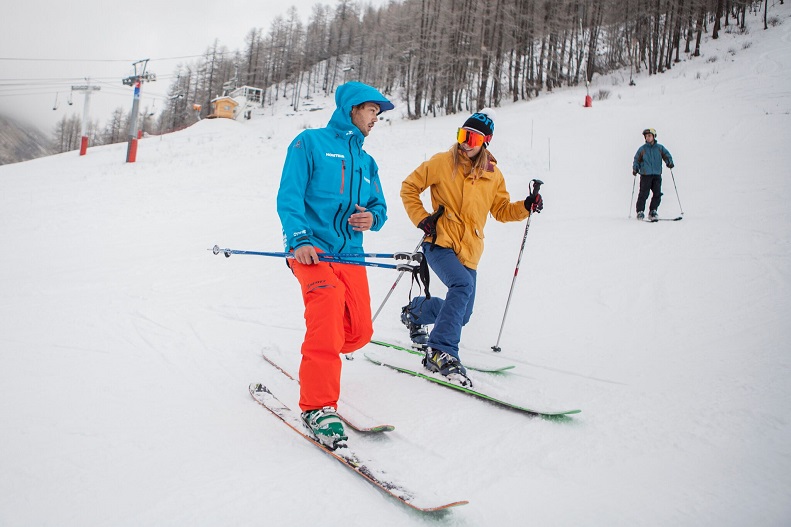
I scramble to my feet and try and regain my dignity on Val d’Isère’s nursery slopes. Setting off once again I’m determined to execute a perfect Telemark turn, or even just an ordinary Telemark turn but my body can’t seem to follow the orders I’m issuing, ‘Slide leg forwards, bend knee, lift heel.’ It sounds so simple but every time I try to do it I find myself making an ordinary parallel turn. I ride lap after lap of the nursery slope. My husband continues to chuckle.
Wondering what I’m doing wrong, I ski over to our teachers, Enrico and Maurizio, a charismatic and enthusiastic pair of Italians who truly delight in Telemarking. They tell of the wonderful feeling you can only achieve when you ‘free the heel,’ loudly proclaiming the superiority of the technique and its devotees. Enrico tells me you must ‘enjoy the burn of your thigh,’ which is all very well but I still can’t get my leg to bend correctly, so what then? ‘Open up and hold your head high,’ I’m told. Minutes later I’m on the floor again.
Skiing a final few laps of the piste, I try harder than ever to figure out why I can’t Telemark turn, becoming ever more perplexed at my body’s inability to do what I have in mind. I pass my husband on each lap, trying to show at least some style so he has something to capture on camera; the cover shot is looking increasingly unlikely. Beginning to despair and getting quite cross at my unanticipated inadequacy, I ski over to where he’s standing to tell him how annoying I’m beginning to find Telemarking. He says he’s some advice and picks up his camera to show me where I’m going wrong. ‘I don’t think you’re meant to cross your skis,’ he says, helpfully. I call it a day and head to the bar.

Try it yourself
VIP SKI offers tailor made Learn To Telemark packages throughout the winter in Val d’Isere, France. We stayed at CLUB Bellevarde on the edge of the slopes, enjoying superb meals and VIP SKI’s chalet service. A week’s stay in December at CLUB Bellevarde is priced from £699pp including all meals and VIP SKI’s chalet service and flights (£649 exc flights). More information can be found at www.vip-chalets.com.
- Hire: Ski equipment can be hired from Oxygene, visit
oxygene-ski.com/en/val-disere for more information about pricing.
- Tuition: One hour private tuition with Oxygene is priced from 63€ / £45 for ski, snowboard and Telemark lessons. Visit oxygene-ski.com.
- Lift pass: A six day adult lift pass for adults for Val d’Isere and Tignes is priced from 243€ / £175. For more information visit www.valdisere.ski for more information.
- Flights: Return flights from Bristol to Geneva are available from £61 with easyJet..
For more information on Val d’Isere please visit: www.valdisere.com.
For more information on VIP SKI please visit: www.vip-chalets.com.
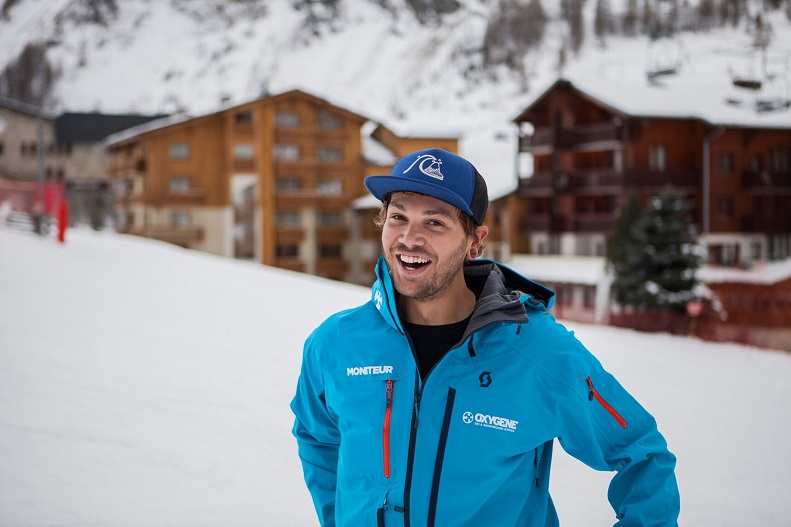
The Kit
- The skis:
Thanks for their origins in cross-country skiing, even as late as the 1980s Telemarking skis were long and narrow. Though specialist Telemarking skis do exist, Telemarking can be done on most kinds of touring, alpine and freeride skis and these days you’re more likely to spot Telemarkers using something shorter and wider.
- The bindings:
With a sprung cable fastened to the back of the boot, Telemark bindings secure the toe to the ski and leave the heel free to lift. Most bindings are either the traditional 75mm ‘duck-bill’ toe system or the more recently invented NTN (new Telemark norm) variety. Unlike on Alpine skis, Telemark bindings are usually not quick release.
- The boots:
Modern telemarking boots are multi-buckled plastic affairs, with a flexible front to allow the foot to bend as the heel is lifted. 75mm ‘duckbill’ boots feature a wedge shaped toe, that slots securely into the binding, whereas NTN boots use a lug under the toe of the foot, which is clamped to the binding. Size and fit is very important, as the foot must be securely anchored whilst you lift your heel and execute a Telemark turn.
- Goggles:
It’s important to protect your eyes even when it’s overcast as UV rays bounce off the snow as well as increasing with altitude. Dragon’s frameless NFX goggles make switching lenses a piece of cake and offer an unobstructed view.
- Clothes:
I opted for Vans’ Mountain Edition jacket and trousers with a built-in ‘powder skirt’ that zips the two together to keep out of your pants. The breathable, waterproof fabric kept me warm, dry and comfortable and retro styling ensured I looked the part.
- Gloves:
With your extremities most likely to feel the cold on the slopes, thick Gore-Tex gloves are my non-negotiable luxury when in the mountains.

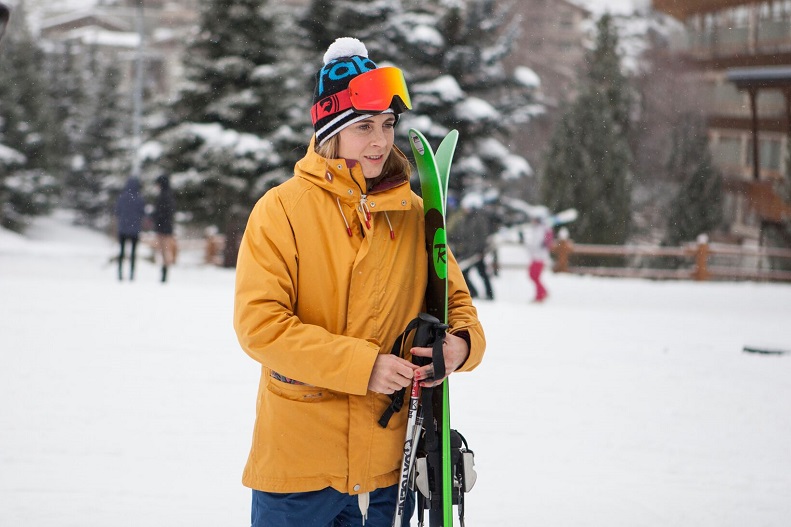
All images credit to: Dave Noakes
This article is a feature piece from Totally Active, a completely interactive online magazine written by active people for active people. Totally Active are on a mission to push endurance to its limits, to help readers achieve their potential, whatever the sport or activity. Totally Active have brought some of the world’s foremost endurance, performance, nutrition and fitness experts together in a publication which informs and inspires readers to go to the edge, to break boundaries, and to succeed. Read more articles like this at Totally Active today.

